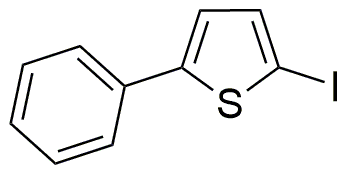2-Iodo-5-phenylthiophene is widely utilized in research focused on:
- Organic Electronics: This compound is used in the development of organic semiconductors, which are essential for creating flexible electronic devices such as OLEDs (Organic Light Emitting Diodes) and organic solar cells, offering advantages in lightweight and low-cost production.
- Pharmaceuticals: It serves as an intermediate in the synthesis of various pharmaceutical compounds, helping researchers design new drugs with improved efficacy and reduced side effects.
- Material Science: The compound is employed in the creation of advanced materials with specific electrical and optical properties, which are crucial for applications in sensors and photonic devices.
- Research in Conductive Polymers: It plays a significant role in the development of conductive polymers, which are used in a variety of applications from anti-static coatings to flexible circuitry.
- Photovoltaic Research: The compound is investigated for its potential in enhancing the efficiency of photovoltaic cells, contributing to the advancement of renewable energy technologies.
Informations générales
Propriétés
Sécurité et réglementation
Applications
2-Iodo-5-phenylthiophene is widely utilized in research focused on:
- Organic Electronics: This compound is used in the development of organic semiconductors, which are essential for creating flexible electronic devices such as OLEDs (Organic Light Emitting Diodes) and organic solar cells, offering advantages in lightweight and low-cost production.
- Pharmaceuticals: It serves as an intermediate in the synthesis of various pharmaceutical compounds, helping researchers design new drugs with improved efficacy and reduced side effects.
- Material Science: The compound is employed in the creation of advanced materials with specific electrical and optical properties, which are crucial for applications in sensors and photonic devices.
- Research in Conductive Polymers: It plays a significant role in the development of conductive polymers, which are used in a variety of applications from anti-static coatings to flexible circuitry.
- Photovoltaic Research: The compound is investigated for its potential in enhancing the efficiency of photovoltaic cells, contributing to the advancement of renewable energy technologies.
Documents
Fiches de données de sécurité (FDS)
La FDS fournit des informations de sécurité complètes sur la manipulation, le stockage et l’élimination du produit.
Spécifications du produit (PS)
Le PS fournit une description complète des propriétés du produit, notamment sa composition chimique, son état physique, sa pureté et les exigences de stockage. Il détaille également les plages de qualité acceptables et les applications prévues du produit.
Certificats d'analyse (COA)
Recherchez des certificats d'analyse (COA) en saisissant le numéro de lot du produit. Les numéros de lot et de lot se trouvent sur l'étiquette d'un produit, après les mots « Lot » ou « Lot de fabrication ».
Numéro de catalogue
Numéro de lot/série
Certificats d'origine (COO)
Ce certificat d'exploitation confirme le pays dans lequel le produit a été fabriqué, et détaille également les matériaux et composants utilisés et s'il est issu de sources naturelles, synthétiques ou autres sources spécifiques. Ce certificat peut être requis pour les douanes, le commerce et la conformité réglementaire.
Numéro de catalogue
Numéro de lot/série
Fiches de données de sécurité (FDS)
La FDS fournit des informations de sécurité complètes sur la manipulation, le stockage et l’élimination du produit.
DownloadSpécifications du produit (PS)
Le PS fournit une description complète des propriétés du produit, notamment sa composition chimique, son état physique, sa pureté et les exigences de stockage. Il détaille également les plages de qualité acceptables et les applications prévues du produit.
DownloadCertificats d'analyse (COA)
Recherchez des certificats d'analyse (COA) en saisissant le numéro de lot du produit. Les numéros de lot et de lot se trouvent sur l'étiquette d'un produit, après les mots « Lot » ou « Lot de fabrication ».
Numéro de catalogue
Numéro de lot/série
Certificats d'origine (COO)
Ce certificat d'exploitation confirme le pays dans lequel le produit a été fabriqué, et détaille également les matériaux et composants utilisés et s'il est issu de sources naturelles, synthétiques ou autres sources spécifiques. Ce certificat peut être requis pour les douanes, le commerce et la conformité réglementaire.


